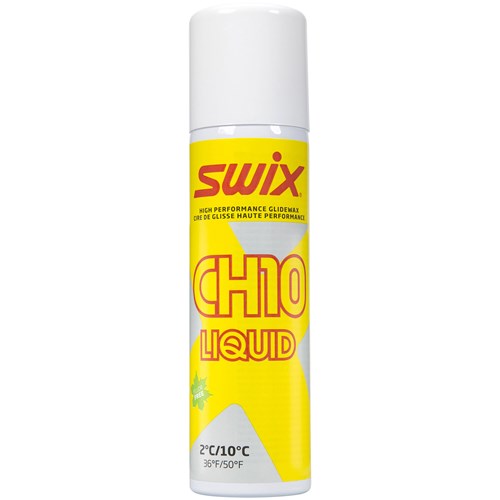- Product number CH10XL-120
- Country of origin:Schweiz
- Gender:01NoRelevance
- Season:Fall/Winter
- Concept:Base
CH10X Liq.Yellow, 2C/10C, 125ml
Super fluid and very durable glide wax for training.
We do not currently ship to your location
Please contact your local retailer or change your settings below
Product information
Technical specifications
Danger
H-sentence number: H222, H229, H319, H336
H-sentence: Extremely flammable aerosol. Pressurized container: May burst if heated. Causes serious eye irritation. May cause drowsiness or dizziness.
FAQ
- Liquid glide wax Fiberlene; Nylon Brush; Combi cork
- Heat in the glide wax: Waxing iron; Brush; Plexi scraper; Scraper; Fiberlene
Which ski wax do I need to glide skis with?
To glide your skis, you need a glider. There are many types from simple (F4 ), liquid glide wax (HS6 Liquid ) to more advanced glide waxes that need to be heated (HS6 ) onto the ski base.
The easiest way: F4-100C Glidewax
With waxing iron: Video - How to glide cross-country skis
Liquid glide wax (without waxing iron): How to easily get a good glide without a waxing iron
What is glide wax and how do I use it?
Glide wax is what you use on the ski base to make it glide better in different conditions. There are different types of glide waxes that have different areas of use.
The easiest to apply require a sponge (F4-100C Glidewax ) or spray (HS6 Liquid ) onto your ski without doing anything else. The most advanced are applied in several rounds using a waxing iron (HS6 ).
Videos: Swix school – How to prepare the skis
How and why do I need to glide my skis?
There are many ways to do it, but the reason is the same; you want better glide and thus a better skiing experience.
You also care for your skis in the process and they will last much longer.
Learn more here: Swix school – How to prep your skis
My skis are brand new. What do I need to do in the glide zone?
We recommend that you saturate new skis before use. This means that you add a glide wax to the ski base to prevent the ski from drying out. If you have white tracks in your skis, that's a sign that your skis are dry.
New skis should be saturated with a soft glide wax, e.g. PS10. Heat the glide wax into the base, wait until it has cooled down and reheat the glide wax. Follow with glide wax so that you always have wax between the waxing iron and the base.
Repeat the process until you have heated in the glide wax 6–8 times. Scrape and brush off before heating a layer of hard glide wax, e.g. HS6. Heat a few times, scrape and brush, and then apply the glide wax recommended for the day's conditions in the same way.
Videos: Swix school – How to prepare skis
What equipment do I need to wax my skis with a glide wax?
You don't need any equipment other than a liquid F4 glide wax. It’s all about how much effort you want to put in and what performance you want.
If you want the best possible skis, you need different types of glide waxes, drills, fiberlene glide cleaner, different types of rotobrushes, wool and fleece, scrapers and an iron.
For example
How often should I glide/wax my skis?
We recommend glide waxing as often as possible. Preferably for every 100 km up to 150 km with melt-in glide wax.
One tip is to use liquid glide wax (e.g. HS6 ) after each ski session. This will protect your skis and you can easily brush off just before your next session to get the best glide possible. You will need: Fiberlene; Nylon Brush; Combi cork
Video: How to apply liquid glide wax without a waxing iron
For every 100 km up to 150 kilometers, you should heat the glide wax onto the skis to refill the base. You will need: Waxing iron; Brush; Plexi scraper; Scraper; Fiberlene
Video: How to glide cross-country skis
How many layers of glide wax do I need to apply?
If the skis are dry, the skis will look a little white/gray, and then you should saturate the skis by heating in a soft glide wax, such as PS10, several times.
After this, you should apply a hard and protective glide wax, like HS6, before you lay the glide wax recommended for the day's conditions, which can be a fine spray glide wax (HS6 Liquid ) for sessions of less than 30 km.
Is liquid wax as good as gliding wax you have to melt in?
Yes, on many types of skis, liquid glide waxes have proven to be just as effective– if not better – than solid glide waxes.
This article explains the differences between the different glide waxes in the Pro by Swix series.
Which ski wax should I choose as a beginner, for training or racing?
If you want the type of glide wax that you apply to your skis without melting in and without applying base prep glide wax, we recommend the F4 glide wax.
If you want to go one step further, you can invest in PS10, PS6 and HS liquid 6 and HS liquid 8, as well as a waxing iron, a combi brush and a scraper to prepare your skis for training.
If you want the best possible skis, you will need a lot of equipment and many different types of glide waxes. Check out our guide: Swix school – How to prep your skis
What is the difference between the PS, HS and TS glide waxes in the Pro by Swix range?
PS is made for ski sessions and training, HS is made for training and competing and TS for racing. Find Swix glide wax here.
In this article you can read the difference between the gliders in the Pro by Swix series.
How to remove old ski wax
Apply Base Cleaner and Fiberlene to the grip zone. In the glide zone, apply glide wax cleaner and fiberlene so that you do not remove the glide wax, only the dirt and muck.
How to remove old glide wax
How to remove old grip wax
What is the difference between Marathon as a hard wax and in powder form?
The powder makes it easier to melt in the glide wax. Marathon is an extremely hard glide wax that many people find difficult to heat properly into the ski base. We have therefore launched the glide wax in powder format. The glide wax is the same regardless of what you choose, but it is easier to get a good result with the powder as mentioned.
Swix Marathon glide wax is applied with Roto Wool: Get a better glide with a rotobrush
Swix Marathon Powder is applied with a waxing iron: How to apply Marathon powder
Shipping & returns
Free shipping over 1000 kr or 79 kr under this value.

